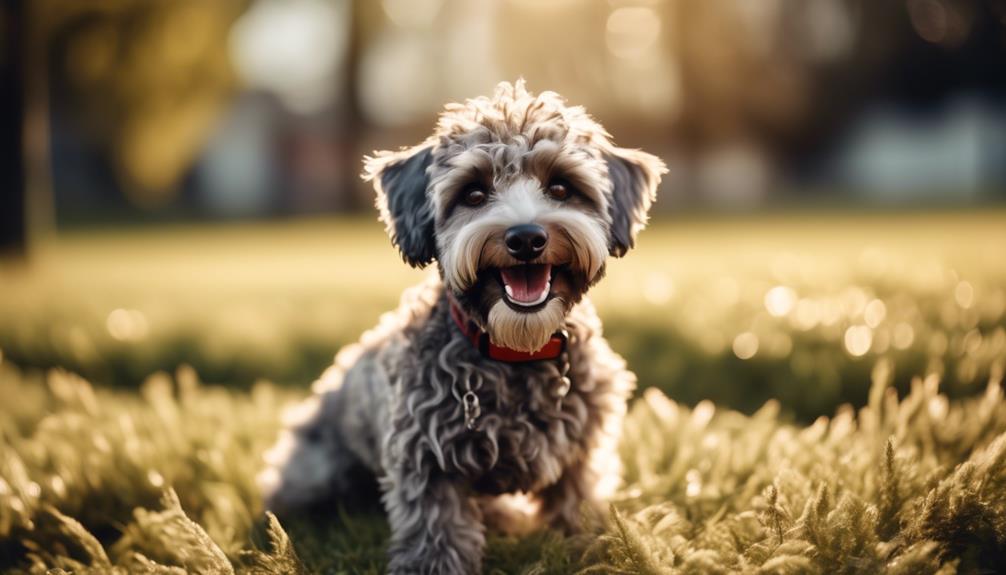
Schnoodles, the sensational hybrid breed, have captured the hearts of dog enthusiasts with their charming characteristics and captivating appearance. But what makes these furry friends truly special?
It’s not just their adorable faces or their curly, hypoallergenic coats. No, there’s something more to these delightful dogs, something that sets them apart from the rest.
In this article, we will uncover the secrets behind the Schnoodle’s origin and size variations, revealing fascinating insights into their lifespan, temperament, training needs, and health concerns.
So, buckle up and get ready to embark on a journey into the world of Schnoodles, where surprises and discoveries await at every turn.
Key Takeaways
- Schnoodles are a crossbreed between Poodles and Schnauzers, first bred in the United States in the 1980s.
- They come in four different sizes, ranging from Toy to Giant, and have a curly, low-shedding coat that can be various colors.
- Schnoodles are known for their friendly, intelligent, and playful temperament, making them great companions for families and other pets.
- They require moderate exercise, are easy to train, and have a lifespan of 12-15 years. However, they can be prone to certain health issues such as allergies and pancreatitis.
Origin and Size
The Schnoodle dog breed originated in the United States in the 1980s by crossing Poodles and Schnauzers, resulting in a variety of sizes ranging from toy to giant. This deliberate crossbreeding aimed to create a dog that possessed the intelligence and hypoallergenic qualities of the Poodle, combined with the Schnauzer’s friendly and loyal nature.
The Schnoodle comes in four sizes: Toy, weighing between 5-15 pounds; Miniature, weighing between 15-30 pounds; Standard, weighing between 30-50 pounds; and Giant, weighing between 50-70 pounds. These size variations allow potential owners to choose a Schnoodle that best fits their lifestyle and living arrangements. Whether they’re looking for a small companion or a larger, more active dog, the Schnoodle offers a size option for everyone.
See another Dog breed profile.
Scottish Deerhound Dog Breed
Lifespan and Coat
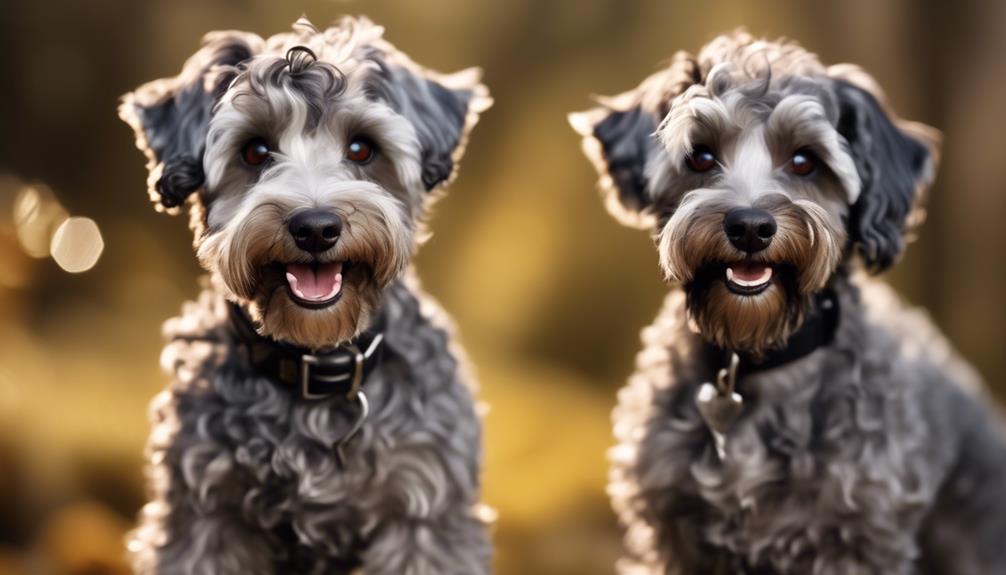
After discussing the origin and sizes of the Schnoodle dog breed, it’s important to now explore their lifespan and coat characteristics.
- Lifespan: Schnoodles typically live for 12 to 15 years, providing their owners with many years of companionship and love. This lifespan is relatively long compared to other dog breeds, making Schnoodles a great choice for those looking for a long-term furry friend.
- Coat: Schnoodles have a curly, low-shedding coat that’s highly sought after by many pet owners. Their coats come in a variety of colors, including black, grey, brown, white, apricot, and parti. The soft and curly nature of their coat gives them a teddy bear-like appearance, earning them the nickname ‘teddy bear dogs’.
Understanding the lifespan and coat characteristics of Schnoodles allows potential owners to make an informed decision about whether this breed is the right fit for them. With their long lifespan and beautiful coat, Schnoodles are sure to bring joy and companionship to any loving home.
Temperament and Exercise
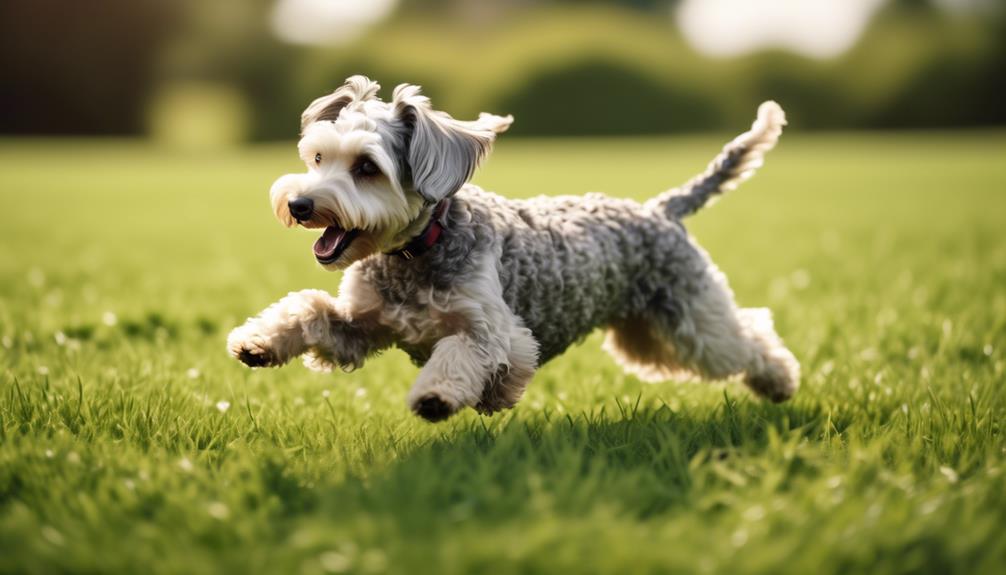
Schnoodles have a friendly and playful temperament, making them great companions for individuals and families alike. They’re known for being intelligent, loyal, and good with children and other pets.
When it comes to exercise, Schnoodles have moderate needs and require at least 30 minutes of physical activity per day. They enjoy playing fetch, going for walks, and running around in the yard.
Training a Schnoodle is usually a breeze, as they’re smart and eager to learn new tricks. However, it’s important to note that Schnoodles can be barkers, so early training to curb excessive barking is essential.
In terms of grooming, Schnoodles need weekly brushing to prevent mats and tangles and should have professional grooming every few months.
Training and Grooming
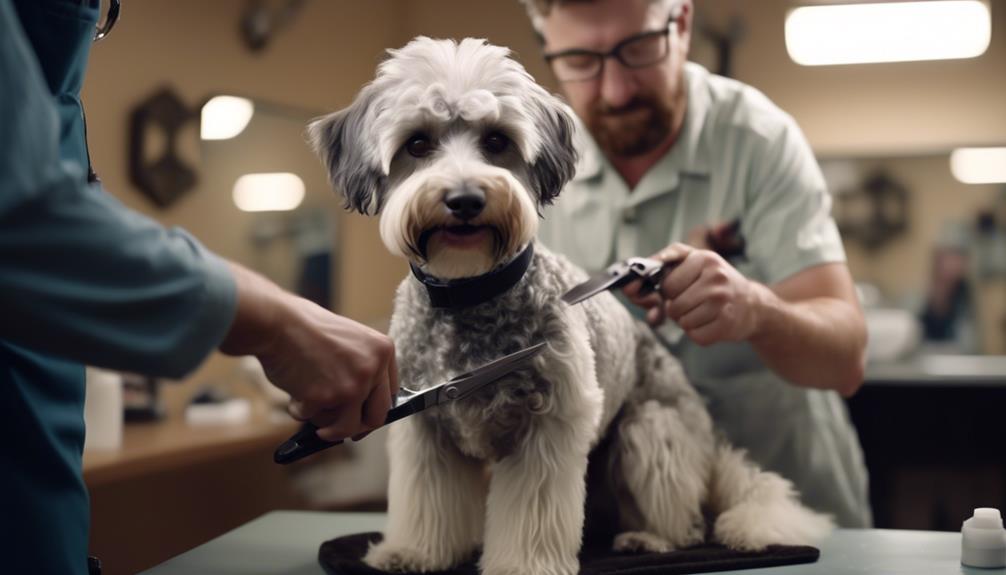
When it comes to caring for a Schnoodle, training and grooming are essential aspects of their well-being. Here are three important points to consider:
- Training: Schnoodles are intelligent and eager to please, making them easy to train. Positive reinforcement methods work best, such as rewards and praise, as they respond well to these techniques. Consistency and patience are key to shaping their behavior and teaching them commands.
- Grooming: Schnoodles have a curly, low-shedding coat that requires regular maintenance. Weekly brushing is necessary to prevent mats and tangles. Professional grooming every few months helps keep their coat in good condition. Additionally, their ears should be checked and cleaned regularly to prevent infections.
- Socialization: Early socialization is crucial for Schnoodles to develop good behavior and proper interactions with people and other animals. Exposing them to different environments, sounds, and experiences from a young age helps them become well-rounded and confident dogs.
Health Concerns
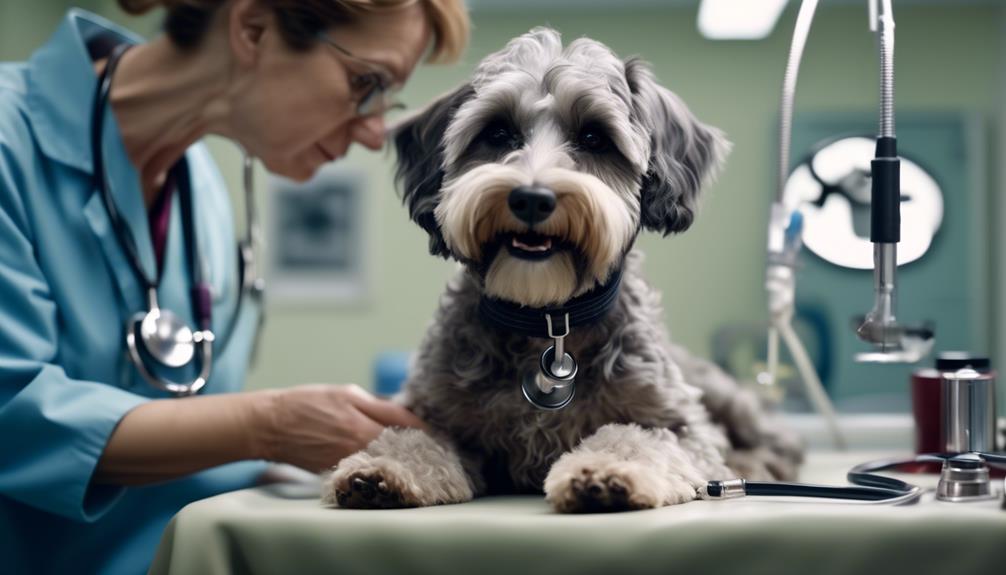
One important aspect to consider when caring for a Schnoodle is their health. Like all dog breeds, Schnoodles are prone to certain health concerns that potential owners should be aware of.
Some of the common health issues seen in Schnoodles include allergies, pancreatitis, and luxating patella. Allergies can cause skin irritations, itching, and discomfort for the dog, while pancreatitis is an inflammation of the pancreas that can lead to digestive problems. Luxating patella refers to a condition where the kneecap becomes dislocated.
Regular veterinary check-ups, a balanced diet, and proper exercise can help mitigate these health concerns. It’s important for owners to be proactive in monitoring their Schnoodle’s health and seeking veterinary care as needed to ensure a happy and healthy life for their furry companion.
Fun Facts
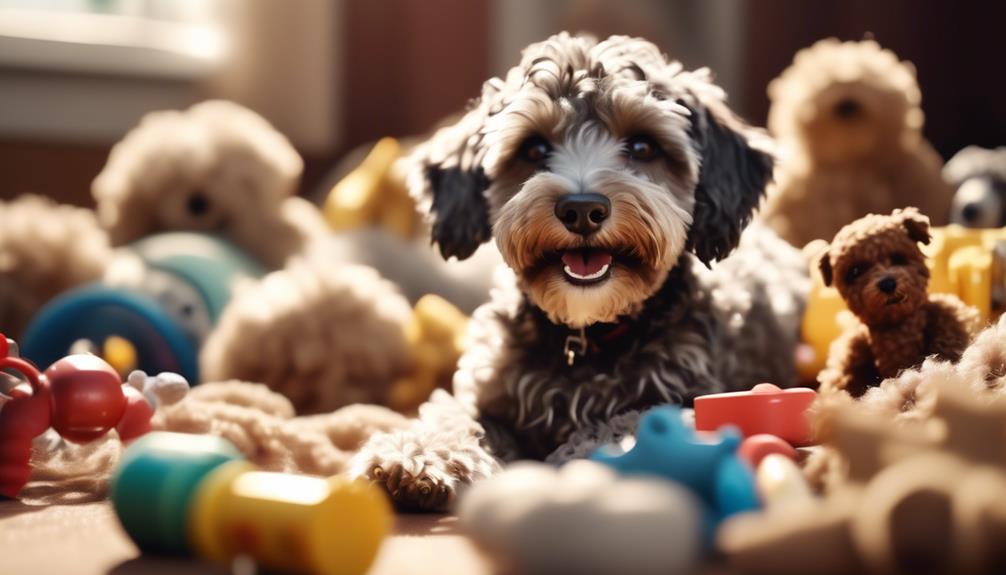
After discussing the health concerns associated with Schnoodles, it’s interesting to explore some fun facts about this unique dog breed. Here are three fascinating things to know about Schnoodles:
- Nicknames: Schnoodles are often called teddy bear dogs because of their soft, curly coats. This adorable nickname perfectly reflects their cuddly and cute appearance.
- Movie roles: Schnoodles have even made their way onto the big screen! In the movie ‘All Dogs Go To Heaven,’ there’s a tan Schnoodle character named Killer. This shows that Schnoodles can be stars too!
- TV mentions: Schnoodles have gained recognition on television as well. In an episode of ‘Rizzoli & Isles,’ the character Dr. Maura Isles mentions the Schnoodle as her favorite hypoallergenic dog breed cross. This highlights the Schnoodle’s popularity and appeal to dog lovers with allergies.
These fun facts add an extra layer of charm to an already delightful breed.
Consider Adoption
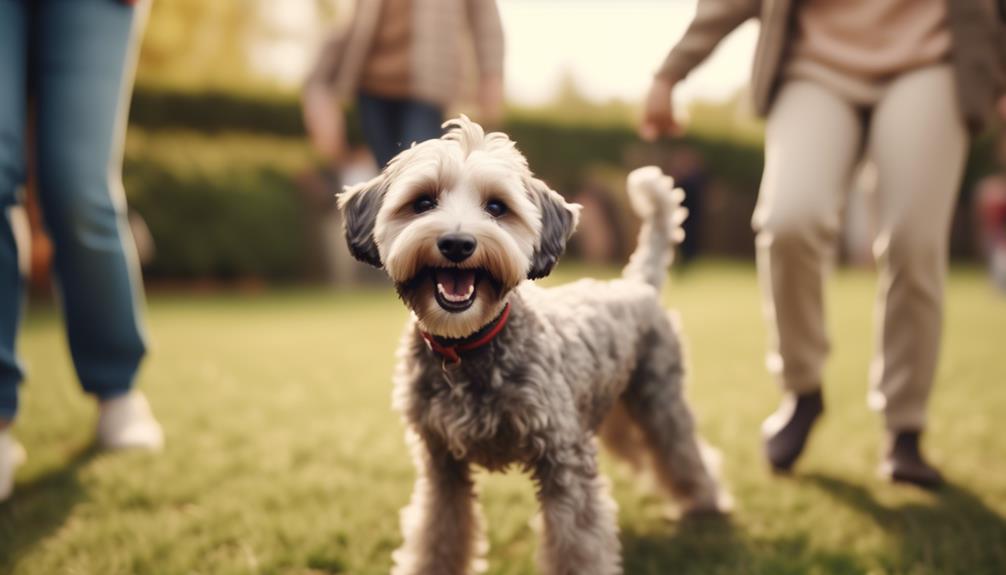
Consider adopting a Schnoodle instead of buying from breeders. Adoption provides a loving home to a dog in need and offers several benefits. If adoption is not an option, it is important to research and find a reputable breeder. Here is a table that highlights the advantages of adoption and the importance of finding a good breeder:
| Adoption Benefits | Finding a Good Breeder |
|---|---|
| Provides a loving home to a dog in need | Ensures the health and well-being of the puppy |
| Saves a life | Helps prevent unethical breeding practices |
| Offers a wide range of ages and temperaments | Provides guidance and support throughout the dog’s life |
| Often more affordable than buying from a breeder | Ensures the puppy is properly socialized and raised |
| Supports animal shelters and rescue organizations | Helps maintain breed standards and promotes responsible breeding practices |
Frequently Asked Questions
Are Schnoodles Good With Children and Other Pets?
Yes, Schnoodles are good with children and other pets. They are friendly, loyal, and playful, making them excellent companions for both kids and other animals. Their temperament and adaptability make them suitable for family environments.
How Often Should a Schnoodle Be Professionally Groomed?
A Schnoodle should be professionally groomed every few months to prevent mats and tangles in their curly coat. Regular brushing at home is also necessary to maintain their coat’s condition.
Do Schnoodles Have a Tendency to Bark Excessively?
Yes, Schnoodles can have a tendency to bark excessively. It is important to train them early to stop excessive barking. They are intelligent and easy to train, so with positive reinforcement, this behavior can be managed.
Are Schnoodles Prone to Any Specific Health Issues?
Schnoodles are prone to specific health issues such as allergies, pancreatitis, and luxating patella. It is important for owners to be aware of these potential conditions and provide proper care and regular veterinary check-ups.
What Are Some Other Hypoallergenic Dog Breeds Besides Schnoodles?
Some other hypoallergenic dog breeds, besides Schnoodles, include Poodles, Bichon Frises, Maltese, Shih Tzus, Yorkshire Terriers, and Portuguese Water Dogs. These breeds are known for producing fewer allergens and are suitable for people with allergies.
Conclusion
In conclusion, the Schnoodle is an intelligent and playful hybrid breed that combines the best traits of the Poodle and Schnauzer. They’ve varying sizes and coat types, but all require regular exercise, training, and grooming.
With their loyal and friendly nature, Schnoodles make excellent companions for dog lovers. Despite their overall good health, potential health issues should be considered.
By adopting a Schnoodle, you not only get a wonderful pet but also provide a loving home for a dog in need.




